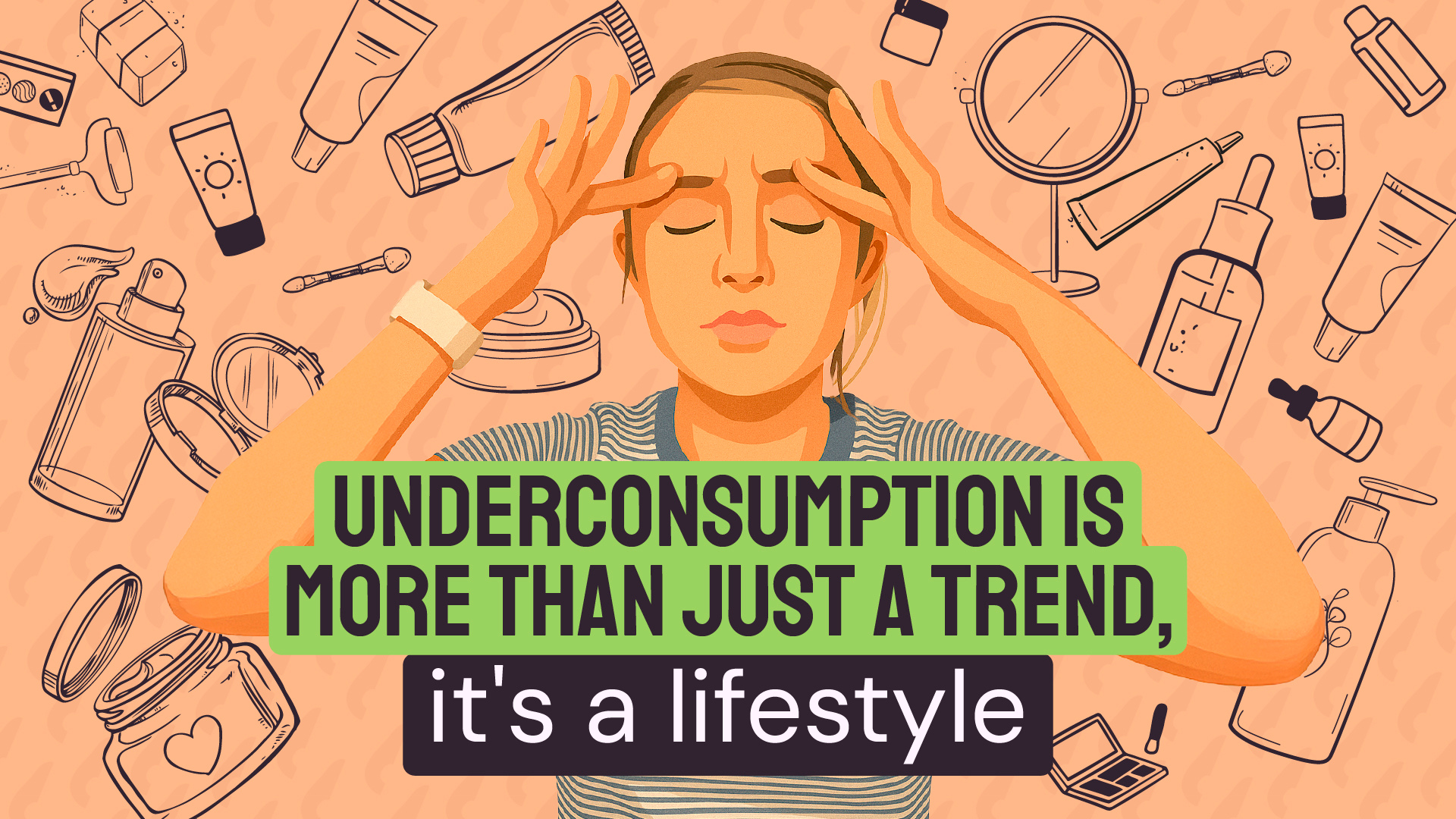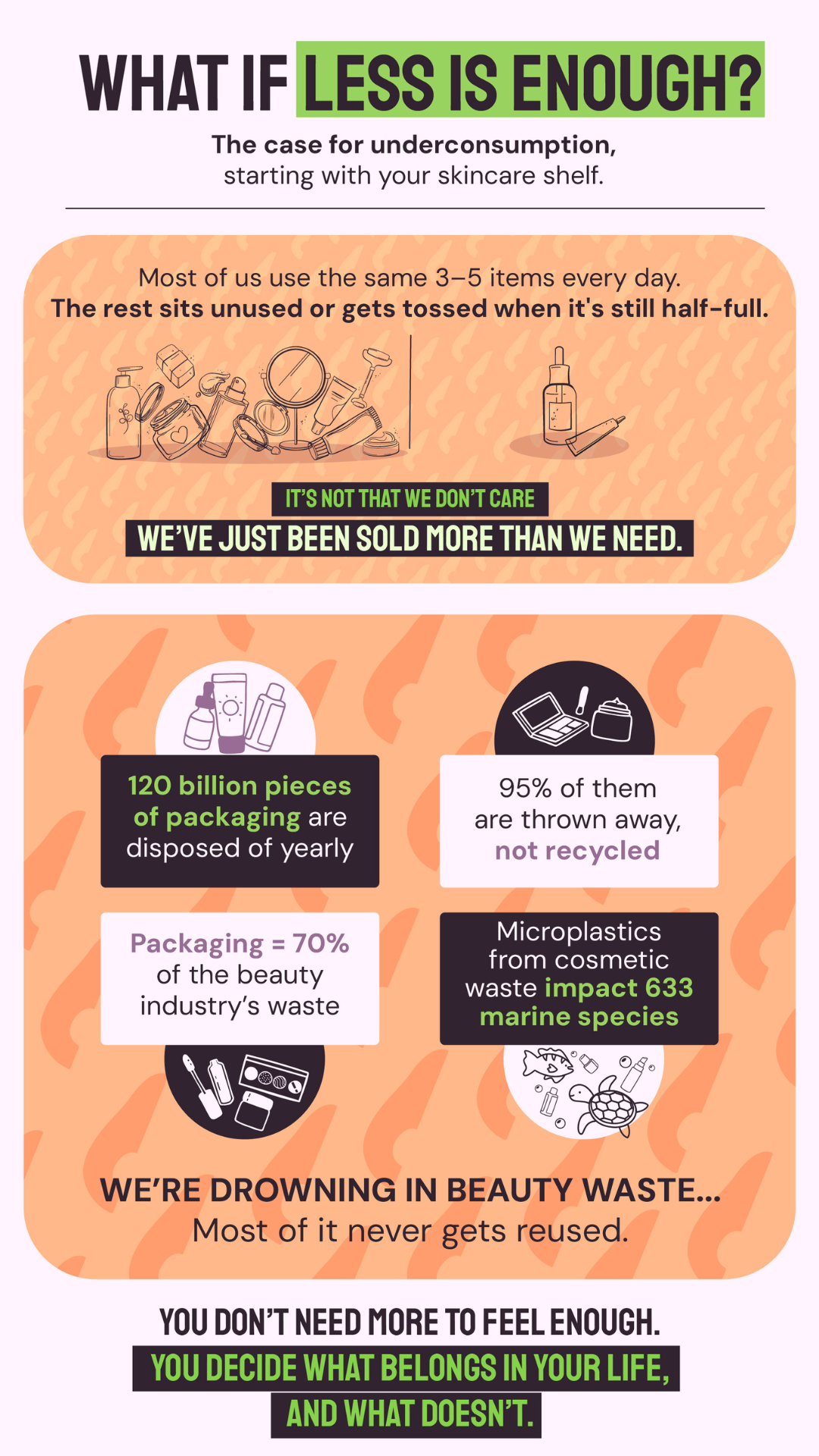What is underconsumption, and why should you incorporate it into your lifestyle?
Underconsumption helps normalize healthy consumer spending habits by encouraging people to spend on only what they need.

In 2024, consumers fought back against overconsumption. They’d been controlled for too long by companies finding every possible way to fuel their desire for MORE.
Suddenly we were seeing underconsumption-core all over our timelines. Instead of unobtainable fast-fashion hauls, we were engaging most with content that romanticized mindful consumption and using and repairing what we already own.
The trend was popularized by a generation of young people who saw overconsumption for what it is: harmful. It resonated with people growing increasingly worried about their financial future. They were fed up with influencers flaunting lavish lifestyles that most people couldn’t, and still can’t, afford. Overconsumption wasn’t just out of touch; it was out of style.
The underconsumption core trend didn’t succeed because it was trendy. It succeeded because young people realized they were being taken advantage of by brands and social media influencers who had their worst interest in mind. They realized that their hard earned money was better spent building their own financial wealth, rather than lining Jeff Bezos’ pockets.
Underconsumption as a simple, but powerful revelation
Social media has a massive effect on our consumer spending habits and companies know this. In fact 64% of Gen Z say that social media influenced them to spend more on beauty products. They’ve figured out the exact formula to drive our need for more.
Companies greenwash, to appeal to young people’s commitment to sustainability. They use mouthpieces we trust (like our favourite influencers), to make us think this product is personally recommended. They know that the world is hard to live in right now, and so that little dopamine hit from a new purchase can be a way for us to feel a bit better for a few minutes.
The underconsumption core trend was a wakeup call that helped young people recognize how harmful their one-sided relationship with brands and social media was. It encouraged them to start second guessing their purchases and be more mindful of how they spend their money.
Those who have adopted the trend have started prioritizing their financially-secure future over these companies’ profits; they are building their savings rather than their collection of facial cleansers.
Why an underconsumption lifestyle is worth it
The underconsumption core trend did a great job of reminding people of different ways they could consume, like cutting foundation tubes in half to get every last drop, or only allowing themselves to buy a new face cream when they finished another one.
For lots of us, these are healthy and normal spending habits, but the trend and the influencers who hopped on it made it cool again. Even so, more needs to be done to connect the dots to show why underconsumption is so important outside of being trendy.

It’s really very simple - when we think we need to buy the newest foundation each month, we physically cannot use it in time. As a result, globally, between 20 and 40% of beauty products end up as waste, with lots of it ending up in our rivers and oceans. It is also unsustainable financially; Canadians spent $9 billion on cosmetics last year.
Young people don’t actually want to waste their money and harm underwater creatures, but consumerism has conditioned us to believe that overconsumption is normal, making it way harder to break out of unhealthy habits. The good news is that it's never too late to start trying!
Tips to help you start under consuming
Underconsumption is a way to take control away from big corporations and put it where it belongs: with YOU.
- Make sure you really want or need the item: If you are on the fence about a purchase, add it to your list of wants and revisit that list in a couple of weeks. If by then you still think the purchase is worth it, go for it! If not, cross it off and fuhgeddaboudit!
- Create spending rules: This will help you think more carefully about your purchases! For example, leaving a “donation bin” in your living room that you add one old item of clothing to every time you buy a new item of clothing. This will help you make the most of old clothing by donating to those who could use it, and make you think twice about if you really need new clothes.
- Track your spending and set a budget: creating a budget is the best way to keep track of your expenses without spending more than you need. Defining how much you spend on your wants versus needs helps create boundaries, making it easier to avoid over spending. If you know your cosmetic budget is out for the month, just scroll on past that latest "get ready with me video." Having a budget will make it that much easier to be mindful and avoid impulse purchases you might never use!
TL;DR
Social media has moved onto the next trend, but underconsumption exposed something really important: consumers are starting to see through the marketing tactics of big companies, and we are also starting to recognize that retail therapy doesn’t actually have lasting effects on our well-being.
Re-evaluating our relationship with consumption is a great way to react to today’s economic landscape, where grocery prices keep creeping up (price-gouging much!!) and landlords keep charging more for rent. It is also a great way to save, and a great way to prioritize our own financial goals over the profit goals of big corporations.
Try it out! Watch your savings grow, your house be less cluttered, your bathroom cupboard be less full of half-used products. Being more mindful allows you to buy what you want, not what someone tells you to want.